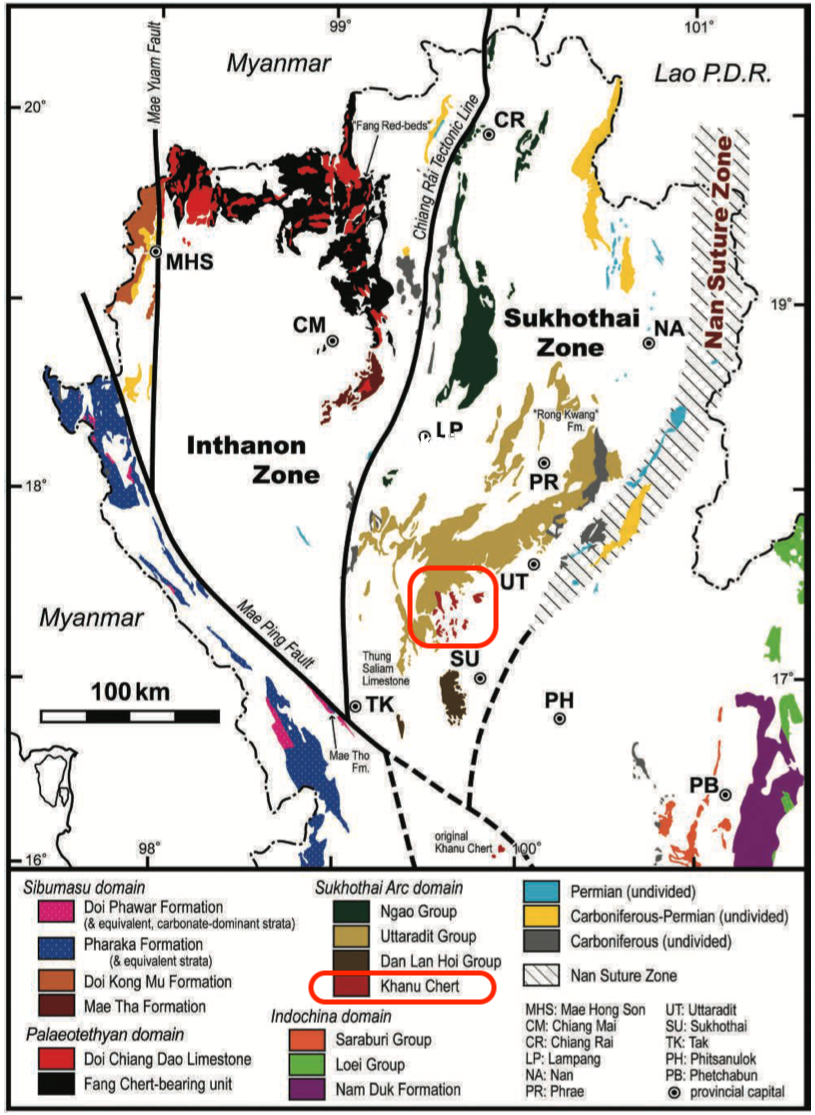Khanu Chert Fm
Type Locality and Naming
The name Khanu Chert was first introduced by Bunopas (1974, 1976c) for a chert-dominated succession in hills near Khanu Woralaksaburi in southeastern Kamphaeng Phet Province. "Although this area was originally chosen as its type section, the Khanu Chert is more extensively distributed around Thung Saliam, about 140 km north of the type area (Fig. 5.3). It is better studied there and the new standard (type) section of this unit was settled at Khao Wong Phrachan between Thung Saliam and Sawankalok, north of Sukhothai (Bunopas 1981)." (Ueno & Charoentitirat, 2011). Therefore, the reference area is small hills between Sawankhalok district and Thung Saliam district, Sukhothai province.
Synonym: หมวดหินเชิร์ตขาณุ
Lithology and Thickness
Originally described as thin-bedded, white, black, grey, brown, blue and green chert with laminae of feldspathic and tuffaceous materials between chert beds (Bunopas, 1981). "However, fieldwork revealed that, contrary to the description by Bunopas (1981), fine siliciclastics (shale and fine-grained sandstone) are the major lithology in the entire succession despite its lithostratigraphic unit name as the Khanu Chert Fm." (Ueno & Charoentitirat, 2011). Thickness: 800 m; although this may be an overestimate caused by structural repetition. [For graphic purposes, a Chert pattern used here to emphasize that component.]
Relationships and Distribution
Lower contact
According to Bunopas (1981), the chert-rich unit is underlain by approximately 70 m of well-bedded phyllitic tuff or tuffaceous phyllite with well-developed cleavage.
Upper contact
Regional extent
Northern Highland: Sukhothai province
Correlation: "Further south, similar chert-dominated strata are also known just NE of Nakhon Sawan city, which was referred to as the Khao Gob Chert by Bunopas (1976a, 1980a)."
GeoJSON
Fossils
"Sashida & Nakornsri (1997) reported Early Permian radiolarians from the Khanu Chert at Khao Wong Phrachan, the new type section adopted by Bunopas (1981). The radiolarian fauna includes Pseudoalbaillella simplex, P. lomentaria, P. scalprata, Ruzhencevispongus sp. and others, and suggests an Early Permian (Asselian – Sakmarian) age. This discovery not only confirmed a Permian age for the Khanu Chert but also highlighted the necessity of re-evaluating the age of siliceous deposits in Thailand which, all too often, have been dated as ‘Silurian – Devonian’ without good fossil evidence." (Ueno & Charoentitirat, 2011).
Age
Depositional setting
"The depositional environment of the Khanu Chert is thought to be relatively deep marine based on its radiolaria-bearing chert, but not necessarily of pelagic ocean-floor origin. If it is accepted that the Sukhothai Zone was an island arc with an abundance of fine- grained volcanic materials, the Khanu Chert probably represents deposition in a slightly deeper fore-arc basin occasionally starved of siliciclastic supply. The chert may even be partly of acid tuff origin." (Ueno & Charoentitirat, 2011).
Additional Information
Parent unit: had been included in the Sukhothai Group (Wongwanich and Boucot, 2011)
